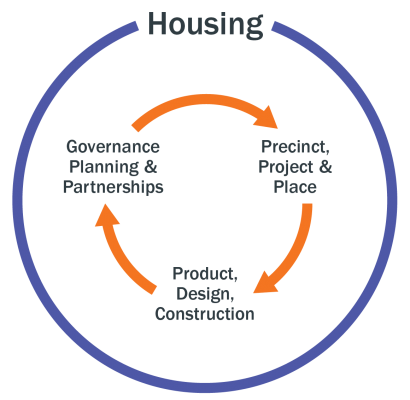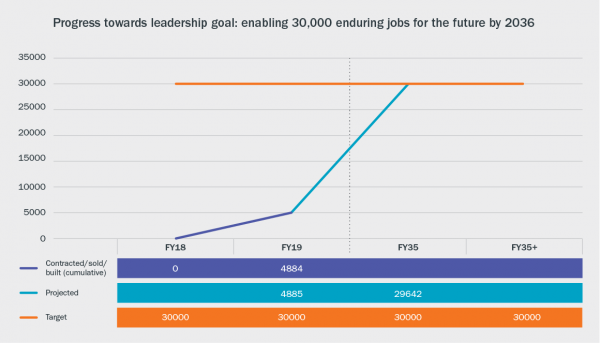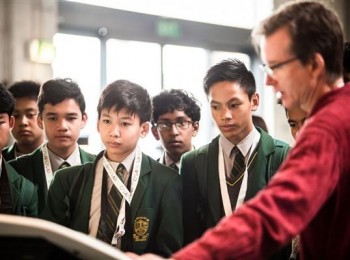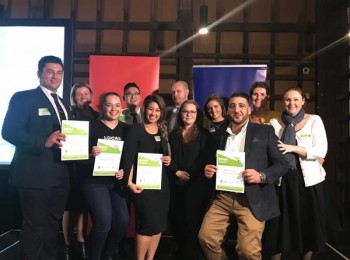Productive Places Pillar Overview
Landcom’s Productive Places pillar is focused on a leadership goal to ‘contribute to the global innovation economy by enabling over 30,000 new jobs by 2036’. This is our economic pillar, committed to delivering places that will be productive and engaging for those that live there.
Read moreRead lessThis leadership goal was developed to reflect Landcom’s commitment to economic development, strengthening technology infrastructure and advancing equitable opportunities for skills development and education.
Landcom addresses the enablement of jobs and innovation through the following focus areas:
- Innovation
- Training and employment.
Each of these focus areas includes a suite of targets to measure our success. Our leadership goal to enable 30,000 jobs across our communities by 2036 is in direct response to the broader NSW government objectives. As at 2036, the Greater Sydney Commission (GSC) forecasts the Sydney region alone will need 817,000 new jobs. As part of Landcom’s mandate, we support these targets by developing great places and mixed-use communities where people can work, live and play.
In August 2017, our Economic Development Working Group49 released an approach for overcoming the challenge of consistently and effectively calculating our efforts in growing jobs. A new policy, and an easy-to-use Jobs Calculator tool, were created to support Landcom in calculating job consistently across our projects.
As a member of the NSW Government’s Common Planning Assumptions Group (CPAG), we are now advocating for the same assumptions embedded in our Jobs Calculator to be adopted by industry.
For Landcom’s FY18 performance for enabling jobs, see Training & Employment Performance Results below.
49 The Economic Development Working Group was established during our operations as Landcom trading as ‘UrbanGrowth NSW’.
| Leadership Goal |
| LEADERSHIP OBJECTIVE Drive the delivery of productive places, and enable jobs for the future. |
| LEADERSHIP TARGET To contribute to a global innovation economy by enabling 30,000 enduring jobs for the future by 2036. |
Management Approach
-
University Roundtable
In 2016 we established a University Framework Agreement, which formalised a collaboration between the NSW Government and eight leading universities across NSW. As part of this agreement the Landcom University Roundtable and Communities of Practice were created.
The Roundtable aims to drive innovative approaches to long-term engagement between government and the universities. It is comprised of senior academics from each partner institution. The Roundtable meets several times a year to review research proposals in areas of urban innovation, as well as to explore new areas for partnership and research.
The Communities of Practice is a channel through which members of the academic community and government can collaborate on research, student engagement opportunities and learning events. Participants represent the diversity of academia — including planning, architecture, urban design, public administration, construction practice, sustainability, data analytics, law, engineering, business and social sciences — and create and contribute to unique research projects as well as report learning outcomes back to their institutions.
For our FY18 targets performance related to the University Round Table, see Innovation Performance Results and Training & Employment Performance Results below.

Our three Communities of Practice
-
Emerging Technologies
Landcom addresses emerging technologies in our Innovation focus area. Currently we are seeking to roll out smart technology to our new communities, in the form of electric vehicle (EV) rapid charge stations, and ensuring all homes have access to high speed internet, while increasing the provision of free Wi-Fi in public places. We see these initiatives as future-proofing communities, reducing inequalities in access to information and ensuring early adoption of future transport technologies.
Ultimately, the provision of EV chargers throughout Landcom communities will improve a community’s overall resilience, reduce its greenhouse gas emissions, and improve transport related cost of living expenses for residents. These targets also contribute to Landcom’s low-carbon transport approach, which includes accessibility to public transport, walkable and cycling-friendly neighbourhoods (see Health, Equity & Inclusion).
For our FY18 activities related to information accessibility and electric vehicles, see Exploring Opportunities for Electric Vehicles below.
-
Education & Skills Development
Landcom is committed to advancing access to education and skills development, for the communities we deliver – now, and into the future. We work with TAFE NSW to develop programs that address the specific skills requirements of a local area, and provide education and training opportunities and employment pathways for locals that may have experienced low or long-term unemployment. We also collaborate with schools and other educational institutions to deliver learning and youth engagement programs that are aligned with the NSW primary and secondary curriculum topics of urban and regional planning studies.
For our FY18 targets performance related to education and skills development, see Training & Employment Performance Results below.
-
Measuring Impact
In FY18 we invested in the Australian Social Value Bank (ASVB)50 tool to help us to better understand and communicate the impact of our sustainability programs and initiatives. In FY18 we commenced using the tool to measure the value of our TAFE and Schools programs. The ASVB contains 62 different social values related to all aspects of Australian life, which have been derived using a cutting-edge approach called Wellbeing Valuation.
The main advantage of Wellbeing Valuation is that the values are consistent and robust. The consistency means that while we may be examining values of different types of outcomes, we are still comparing like with like. This means we can compare the value of our training program against the value of our mental health program, for example.
Wellbeing Valuation is used to calculate the primary benefits to individuals, such as improved self-esteem or stopping smoking, and these values can be used within any Social Return on Investment or Cost-Benefit type analysis or within the ASVB Value Calculator. The ASVB also measures secondary benefits, which includes impacts like cost savings to government via reduced Centrelink payments or increased tax revenue.
To read how we are applying the ASVB and measuring impact, see Training & Employment Performance Results below.
50 Australian Social Value Bank (2018) https://asvb.com.au/
-
Our Future Priorities
In FY19 we plan to release our Reconciliation Action Plan, a draft of which is currently being validated by Landcom’s Future Leaders program participants. Landcom’s Future Leaders program is a cross-divisional talent and development program. Participants are invited to apply to the program, where a business critical project is presented for their recommendations to the Landcom Board. The cohort is supported by a range of training and development opportunities, including a skills development workshop, project mentorship and ongoing individual coaching sessions. For FY18/19 the Future Leaders’ project is focused on how Landcom can better partner with Aboriginal Land Councils.
Additionally, we will review opportunities to advance our approach to Smart Cities, and staff volunteering.
Performance Results
See below our performance results for each of the reporting areas within our Productive Places Pillar.
Innovation Performance Results
Landcom’s Sustainable Places Strategy addresses Innovation. This focus area forms part of our Productive Places pillar, and is a representation of our commitment to advancing innovation through our business, and to our communities.
![]()
FY18 Targets and Performance
| Indicator | Objective | Target | FY18 Performance |
|---|---|---|---|
| Innovation |
To pioneer new ideas and foster opportunities within our innovation economy. |
Measure and report annual investment in research and development supporting our strategy principles of fostering a sustainable environment, driving social equity, enabling an innovative economy and advancing responsible governance |
$875,289 |
|
Greenfield/regional: all new communities provide electric vehicle chargers to service a minimum 10% total dwellings (as either publicly accessible or private use) Urban Renewal/High Density: provide a minimum 10% parking yield, per parking lot, as EV Charge Station ‘turn-key’ ready at development completion |
No new projects in scope51 |
||
|
All homes to have access to high-speed broadband (20Mb+) |
Commitment fulfilled by NBN. Target to be retired. |
||
|
Key open spaces to provide free Wi-Fi access |
No new projects in scope 51 |
51 These targets apply to new projects commenced in FY18; we did not commence any new projects in FY18 for which this target is relevant.
-
Innovation Performance Results
To support this ambition, the Landcom Board has an endorsed commitment to research and learning, which recognises that education and innovation are a core element of our business approach. By collaborating on learning initiatives, our projects offer a unique educational legacy which can help expand innovation, skills and knowledge in urban development.
In FY18, we continued to invest in a range of innovative research through our Landcom University Roundtable and Communities of Practice, as well as started the work to embed innovative technologies such as Electric Vehicle infrastructure into our projects.
-
Our Investment in Research and Learning
In FY18, Landcom contributed $875,289 total investment value into collaborative research led by participants of the University Roundtable; this is in addition to significant in-kind contribution from both Landcom and university employees.52 This is based on agreements executed at or before 30 June 2018. Many projects undertaken by the University Roundtable include long-term research outcomes, and as such may be included across multiple reporting years.
In FY18, active research projects related to Landcom operations included:
- Cooling the Commons — examining urban heat island impacts in Western Sydney
- Co.Built 4.0 — collaborative robotics
- Valuing Creative Placemaking
- Sustainable Food Production
- Healthy Higher Density Living
- From Suburban to Urban, and
- Community Engagement 4.0.
In FY19 new projects focused on New Worker Spaces, Creating the City We Want and Bio-shelters will be commencing.
An independent evaluation of Landcom’s University Roundtable is currently being conducted by the Australia and New Zealand School of Government. Results will help Landcom understand the value and impact of the Roundtable to date, and how it might be more effective in future.
52 The University Roundtable and Communities of Practice is a joint partnership between Landcom, UrbanGrowth NSW Development Corporation and Hunter Development Corporation; data included in this report is focused on Landcom’s contribution only. Due to the organisational restructure during FY18 we are unable to accurately reflect the in-kind contribution of Landcom employees only; we intend to reintroduce this reporting in FY19.
-
Exploring Opportunities for Electric Vehicles
In FY18 Landcom had no projects in scope for our targets related to the provision of electric vehicle (EV) rapid charge stations or shared charging points. This target relates to new Landcom communities, for which we had none in scope this reporting year.
However, during FY18 we partnered with Sustainability Advantage (NSW Office of Environment and Heritage), to identify ways we can advance the provision of EVs across our existing projects, and drive the uptake of EVs by residents of our communities. Through this collaboration, Landcom will have access to information and data sets that support us in communicating the costs, and benefits of providing EVs to future development partners, and residents. This includes a benchmark review of best practice EV adoption in the development sector. Our aim is to drive the uptake of low-carbon transport usage across Landcom communities, using evidence and data. Landcom will also use this data to inform the return on investment of transitioning our own fleet vehicles to EVs.
In FY19 we will communicate the results of this collaborative project.
-
Providing Equitable Access to Information
Landcom is committed to providing residents of our communities with equitable access to information. We believe it’s important that everyone can access the internet, and all the benefits connectivity brings.
As part of the Australian Government’s commitment to rolling out the National Broadband Network, all current Landcom communities have or will have access to high speed broadband. Landcom’s target for all homes to have access to high speed internet is now redundant, and will be retired this year.
However, access to free Wi-Fi in key public spaces remains an ongoing ambition for our organisation, and we will continue to champion this for all new projects. There were no new projects in scope for this target during the reporting period.
Training & Employment Performance Results
Landcom’s Sustainable Places Strategy addresses Training & Employment. This focus area forms part of our Productive Cities pillar, and is a representation of our commitment to advancing needs based education, skills and training to our communities.
![]()
FY18 Targets and Performance
| Indicator | Objective | Target | FY18 Performance |
|---|---|---|---|
| Training & Employment |
To provide opportunities for skills development, education and employment that will support our communities to thrive |
To contribute to a global innovation economy by enabling 30,000 enduring jobs for the future by 2036 |
In FY18 we achieved 4,884 direct jobs (cumulative), and are on track to achieve our 2036 goal (16% of target achieved to date; 99% of target projected to be achieved before 2036) |
|
All Project Teams engage in the University Roundtable Communities of Practice, in partnership with leading Australian institutions (run by the Research and Learning team), supporting student and staff engagement, research and learning outcomes |
In FY18 20 Landcom employees across our Corporate and Project teams participated in Communities of Practice; 4 Landcom projects were actively involved 53 |
||
|
Projects to engage and foster education, learning or employment outcomes via actives or initiatives, based on identified needs of the local and regional community |
In FY18 we delivered our first Skills Exchange program, worked with over 70 schools and engaged with over 4,000 students |
53 Landcom’s Research and Learning Team maintain a Service Level Agreement with the UrbanGrowth NSW Development Corporation. This enables the Corporation to draw on skills and resources from Landcom, for use at their projects such as White Bay Power Station, Airds (Claymore), Green Square, Macarthur Heights and Sydney Metro North West Places.
-
Training & Employment Performance Results
In FY18 we focused on refining our approach to measuring jobs through further development of Landcom’s Job Calculator, and saw a range of ongoing and new work delivered through our Research & Learning area. Highlights included the inaugural Skills Exchange program and Hack4Cities initiative.
We also invested in a calculator provided by the Australian Social Value Bank, to help us articulate the social and economic impact of our TAFE program. Over time this tool will also be expanded to our Climate Resilient Places and Healthy & Inclusive Places pillars.
-
FY18 Targets and Performance
In FY18, all targets for reporting against our Training & Employment, and Innovation commitments were in scope. Our results are presented above.
-
Enabling 30,000 Enduring Jobs
In FY17 Landcom adopted its Jobs Calculator, to advance accurate and consistent calculations of jobs enabled by our operations.
Proxy employment ratios, developed through detailed research and benchmarking, are attributed to various land uses, based on m2 gross floor area. Examples of land uses included are commercial, retail, industrial, community, cultural, tourism, health services, education, storage, hotel, serviced apartment, student housing and residential.
As jobs creation is a long-term goal for Landcom, we report our performance based on the FY actuals, and forecast jobs created for the life of a project. This gives us a clear indication of whether we are on track to meet our 2036 target.
As at FY18, Landcom continues to be on track to meet our commitment to enable 30,000 enduring jobs by 2036.

-
Skills Exchange
In FY18 we launched our first Skills Exchange program for residents in our Airds and Claymore communities. These communities have an identified need for employment pathways for young people and the long-term unemployed.54
Across the program, 13 participants commenced the eight week program, with a total of 10 completions. Participants that completed the program obtained a Certificate II in Resources and Infrastructure Work Preparation, and secured a pathway into full time employment within the construction industry.
While three participants did not complete the program, anecdotal evidence from program organisers noted improved self-esteem and confidence. The projected net benefits of the Skills Exchange program55 total $288,954, representing a cost benefit ratio of 8.43:1. The net benefit per participant is assumed to be $22,227.
To further validate the impact of this program, Landcom will check back with program participants at six months post program completion to gather further insights into the impact of the program, and how we can improve participant experiences in future.
Macarthur Heights will be the site for the next Landcom Skills Exchange program in late 2018, followed by a program in early 2019 at Bonnyrigg.
54 Airds: 26% unemployment rate: https://profile.id.com.au/campbelltown/employment-status?WebID=100; Claymore: 27% unemployment rate: https://profile.id.com.au/campbelltown/employment-status?WebID=100
55 Using the Australian Value Bank Calculator, adopted by Landcom for social return on investment calculations. Calculations assume an initial net benefit of six months directly attributed to the program.
-
Schools Programs
In FY18 Landcom, together with UrbanGrowth NSW Development Corporation, delivered the inaugural Hack4Cities schools event at Western Sydney University on 28 June 2018. The Hack4Cities event engaged over 75 secondary students from public and independent schools in Western Sydney to explore solutions to community-based problems around the future of work.
This unique learning experience was designed to develop students’ critical thinking skills, and instil a collaborative approach to problem-solving to equip them to deal with challenges facing Western Sydney over the next 20 years.
We also ran a Youth Eco Summit for primary and secondary students, a sustainability festival which showcased one of our research projects, Urban Pinboard, and interactive workshops built around the Sydney Metro Northwest Places project.
Landcom also continued to facilitate schools excursion programs at Green Square, White Bay Power Station,56 Edmondson Park and Oran Park Town. Through this program we worked with over 70 schools and engaged with over 4,000 students. Excursions are aligned to the high school curriculum for Year 9 and 12 Geography, including Changing Places, Australia’s Urban Future and Building Better Cities modules.
56 Landcom’s Research and Learning Team maintain a Service Level Agreement with the UrbanGrowth NSW Development Corporation. This enables the Corporation to draw on skills and resources from Landcom, for use at their projects, such as White Bay Power Station.
-
Vocational Education and Training Program
In FY19 we will commence our first Vocational Education and Training (VET) in Schools program. VET in Schools refers to students enrolled in Higher School Certificate (HSC) industry-recognised courses. These VET courses may be delivered by the school or by an External VET provider such as TAFE NSW.
As part of their course, students are required to complete 70 hours of workplace learning over Years 11 and 12. This enables students to gain practical experience, informs their career choices, and builds their employment skills. Employers supervise the students as they practise and extend the specific industry skills they have learned in their course work.
Landcom will host VET Construction course students from Bonnyrigg High School at our Bonnyrigg site commencing late September. Three of our contractors on site will supervise the students.
It is anticipated that the program will be rolled out to other project sites and schools in future.




